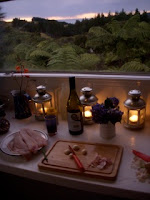Dateline: Auckland, New Zealand; January 20, 2010
Intrigued that I cook in an even smaller kitchen – a narrow, well-appointed galley betwixt a toilet and a shower; perhaps an eighth of the space in a 19.6 by 11.5 foot apartment, formally a motel room - than the one he graces in Los Feliz, Jonathan has invited me to file an occasional culinary piece from New Zealand, where I returned, after two decades working as a journalist in Los Angeles, to pursue an off-the-grid house project in the Coromandel Peninsula. This post is a tour d’horizon of my new life in Godzone; I’ll get into specifics down the road.
I interpret “culinary” in the widest sense. I am just as interested in learning where food comes from, how it is grown, and the sometimes controversial issues surrounding its production, as I am in cooking and eating. In some respects New Zealand is a huge farm. Agriculture is innovative and entrepreneurial – there are no subsidies – but surprisingly resistant, given the country’s pristine environmental hype, to sustainable, organic methods. Still, for those who look there are plenty of delights.
My life is split between Auckland and Coromandel, a three-hour drive around the rim of a spectacular maritime inlet, the Firth of Thames, then up the Pacific Coast Highway, the Antipodean version, a sometimes one-lane blacktop that twists from sea level to some 1,500 feet, then back again.
 I’m now in Auckland, living with my girlfriend Barbara Drake (left, with "pet" Magpie) on the slopes of Mt Albert, one of 49 extinct volcanic “stumps” that litter the narrow isthmus between the Tasman Sea and the Pacific Ocean. It is a maritime city with volatile sub-tropical weather and fertile soil; perfect for fresh sea fish and home grown vegetables - we can hardly keep up with the fecundity of our two tiny plots that keep on giving: silver beet, cabbage, lettuce, rocket [arugula], rhubarb, courgettes, tarragon, thyme, sorrel, nasturtiums, basil, oregano, cilantro and parsley.
I’m now in Auckland, living with my girlfriend Barbara Drake (left, with "pet" Magpie) on the slopes of Mt Albert, one of 49 extinct volcanic “stumps” that litter the narrow isthmus between the Tasman Sea and the Pacific Ocean. It is a maritime city with volatile sub-tropical weather and fertile soil; perfect for fresh sea fish and home grown vegetables - we can hardly keep up with the fecundity of our two tiny plots that keep on giving: silver beet, cabbage, lettuce, rocket [arugula], rhubarb, courgettes, tarragon, thyme, sorrel, nasturtiums, basil, oregano, cilantro and parsley.
Our life is lived in a series of boxes: our city flat, where cooking is a combination of cuisine and choreography; our ‘95 Subaru wagon; two packed-to-the-door storage facilities; and a pair of ancient caravans – one with an almost completed lean-to or sleep-out, largely built from recycled material sourced from community demo yards – on our 27-acre conservation block of regenerating rainforest.
It is a lifestyle – frequent journeys between tiny living spaces – that dictates what we eat. We live on a very cheap budget. Our homegrown veggies are supplemented by organic produce, including fruit, from highway honesty stalls and community gardens in Auckland and Coromandel. Eating well means hooking into food networks, where barter sometimes replaces payment. We also buy fresh fish more or less direct from the boat at various harbours between the city and our land, along with specialist items – cheese, honey, olive oil, wine, condiments or bread – from grassroots producers. We don’t shun supermarkets – rural life hasn’t dented my caffeine habit - but they’re peripheral.
 Thus, the Tarakihi depicted in the picture taken in our caravan, as dusk falls on the Hauraki Gulf and a Morepork, or native owl, starts calling on our block, is that day’s catch, bought from the Coromandel fish ‘n’ chip shop. Our meal, cooked by Barbara on a two-ring gas stove in candlelight, included French beans from the weekly farmers’ market, organic chilli sauce from the sleepy community of Papa Aroha, olive oil from one of our neighbours, garlic from another, toasted kelp harvested from New Zealand’s beaches [five times the length of the US West Coast], plus new potatoes and a 2007 “cleanskin” [end-of-vintage wine, sans label] Gisborne merlot from the local store.
Thus, the Tarakihi depicted in the picture taken in our caravan, as dusk falls on the Hauraki Gulf and a Morepork, or native owl, starts calling on our block, is that day’s catch, bought from the Coromandel fish ‘n’ chip shop. Our meal, cooked by Barbara on a two-ring gas stove in candlelight, included French beans from the weekly farmers’ market, organic chilli sauce from the sleepy community of Papa Aroha, olive oil from one of our neighbours, garlic from another, toasted kelp harvested from New Zealand’s beaches [five times the length of the US West Coast], plus new potatoes and a 2007 “cleanskin” [end-of-vintage wine, sans label] Gisborne merlot from the local store.Like the US, New Zealand is rediscovering the delights of home grown produce. Gardening networks, including community gardens where some food is free, are emerging. Ironically, for a nation where farm produce is the major export [and sometimes cheaper in Trader Joe’s than it is in an Auckland supermarket], and “clean and green” a national catchphrase [and, as the Guardian pointed out, sometimes a hollow one; more on that at a later date], kiwis rank third on the 2009 OECD obesity list, after the US and Mexico, a consequence of a generation weaned on processed and fast foods. I’ll be exploring these themes, and local cuisine, on future posts.
©2010 Peter Huck



